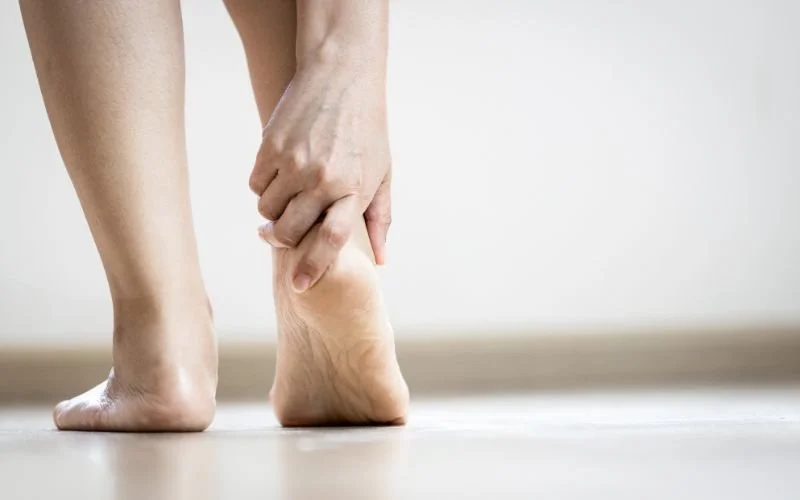Plantar Fasciitis: Symptoms, Causes, and Effective Treatments for Heel Pain
Plantar fasciitis is one of the leading causes of heel pain, particularly among those between the ages of 40-60, runners and individuals who spend long periods on their feet, those with flat or high arched feet or people who are overweight.
This condition results from inflammation of the plantar fascia, a thick band of tissue that runs across the bottom of the foot, connecting the heel bone to the toes.
In this blog, we’ll explore the symptoms, causes, and treatments for plantar fasciitis, along with tips for managing this common condition.
What is Plantar Fasciitis?
Plantar fasciitis occurs when the plantar fascia becomes inflamed or irritated. This condition typically develops gradually and repeated stress can cause small tears in the tissue, leading to foot pain and stiffness.
Symptoms of Plantar Fasciitis
The hallmark symptom of plantar fasciitis is a sharp pain in the bottom of the foot, near the heel. The pain is often worse after periods of inactivity, such as when you first get out of bed in the morning or stand up after sitting for a while.
Morning Heel Pain
Many people experience the most intense pain during their first few steps in the morning. The pain may feel like a stabbing sensation in the heel and usually decreases as you begin to move around.
Pain After Prolonged Activity
While the pain may ease during activity, it often returns after prolonged periods of standing, walking, or running. This is due to the strain placed during movement, which can lead to further irritation and inflammation.
Stiffness and Tenderness
In addition to pain, you may experience stiffness or tenderness in the heel and along the arch of the foot. This is often most noticeable after rest and can make it difficult to walk or stand comfortably.
If you are experiencing these symptoms, it is important to seek treatment early to prevent further damage.
Causes of Plantar Fasciitis
There are several factors that can contribute to the development. The most common causes include:
1. Repetitive Stress from Running
Running or high-impact activities can place repeated stress on the plantar fascia, causing small tears in the tissue and leading to heel pain. This is especially common in runners who suddenly increase their distance or intensity without proper conditioning.
2. Poor Foot Mechanics
Individuals with flat feet, high arches, or abnormal walking patterns are at higher risk. Improper alignment of the feet can lead to imbalances that cause pain and inflammation.
3. Inadequate Footwear
Wearing shoes with poor arch support or inadequate cushioning can contribute to the development of plantar fasciitis. This is especially true for those who spend long periods standing or walking in shoes that don't provide proper support.
4. Occupations That Require Prolonged Standing
People who work in occupations that require long periods of standing or walking, such as teachers, nurses, or factory workers, are more likely to develop symptoms due to the constant strain on their feet.
Effective Treatments for Plantar Fasciitis
Treatment focuses on relieving pain, reducing inflammation, and improving alignment to prevent future issues.
1. Rolf Method of Structural Integration
The Rolf Method of Structural Integration is a form of therapeutic bodywork that focuses on improving the body’s alignment by working with the fascia (connective tissue). By addressing imbalances in the foot and lower leg, this method helps relieve tension in the plantar fascia and improves foot function
2. Massage Therapy
Massage therapy is another effective treatment. By working on the muscles and fascia in the foot, massage can reduce inflammation, improve circulation, and relax the tissues around the heel and arch.
3. Stretching and Strengthening Exercises
Stretching the Achilles tendon, and calf muscles can help reduce pain and improve flexibility. Strengthening the muscles around the foot and ankle can also support the arch and relieve pressure.
4. Postural Correction
Poor posture and improper foot mechanics can exacerbate plantar fasciitis. By improving alignment through posture correction and targeted therapies, Madeleine can help relieve the strain on the feet and prevent further injury.
5. Yoga Therapy
Yoga therapy improves flexibility and strengthening the muscles in the feet and legs. Certain yoga poses can stretch the plantar fascia and Achilles tendon, reducing stiffness and pain. Yoga also encourages proper posture, which helps alleviate foot strain.
Tips for Preventing Plantar Fasciitis
Preventing plantar fasciitis requires a combination of proper footwear, stretching, and lifestyle adjustments. Here are some tips to help avoid this painful condition:
Wear supportive shoes: Choose footwear with good arch support and cushioning, especially if you spend a lot of time on your feet or participate in high-impact activities like running.
Stretch and strengthen regularly: Incorporate stretches and strengthening exercises for your feet, calf muscles, and Achilles tendon into your daily routine to maintain flexibility and reduce tension.
Avoid overtraining: If you're a runner, increase your mileage gradually and give your feet adequate time to recover between runs.
Improve posture: Proper posture can reduce strain on your feet and prevent the misalignment that leads to plantar fasciitis.
Get Professional Relief for Plantar Fasciitis at MZ Therapy
Contact Madeleine to get help with your foot pain in Bath or at her home studio in Stanton Prior.


